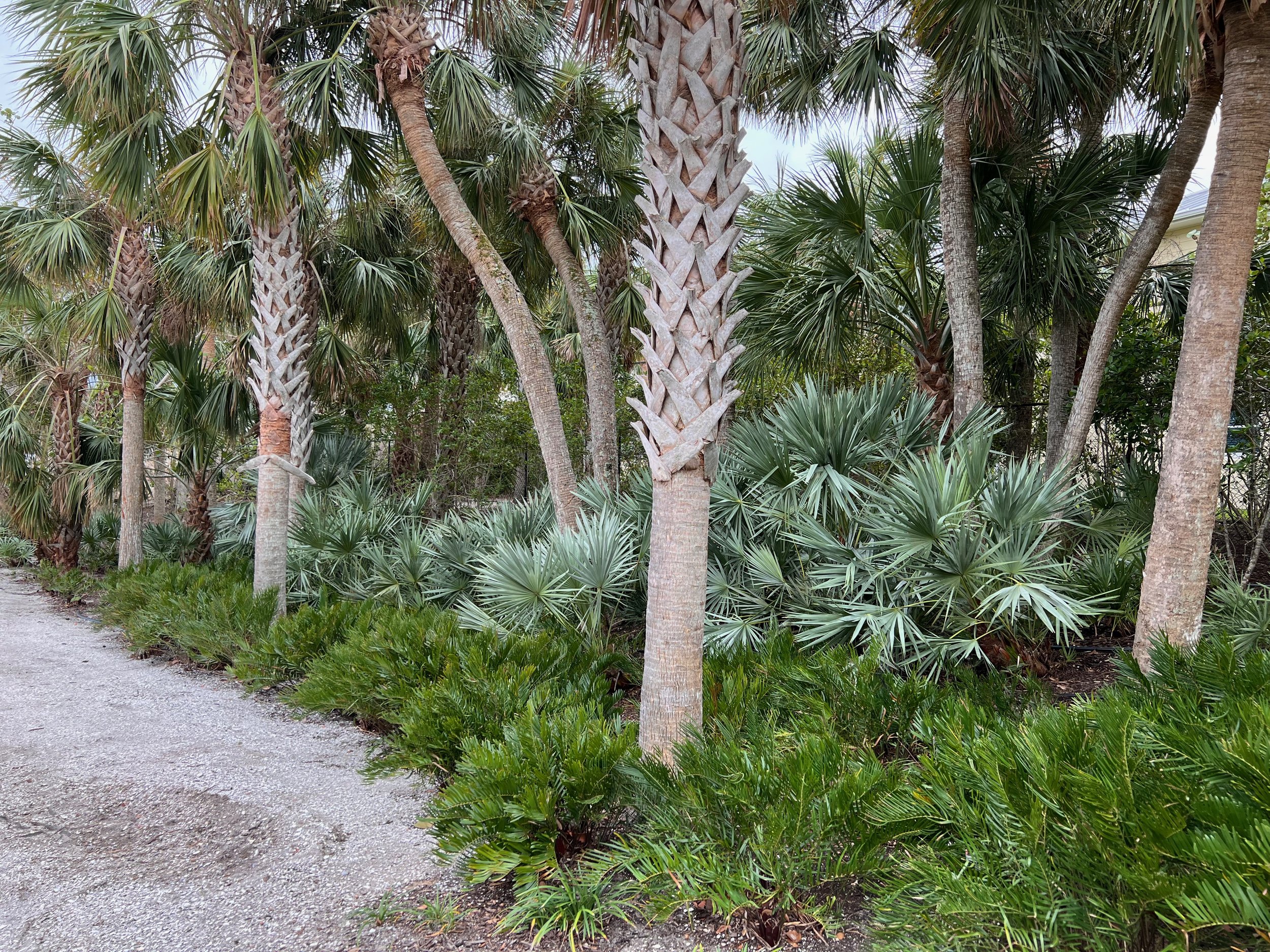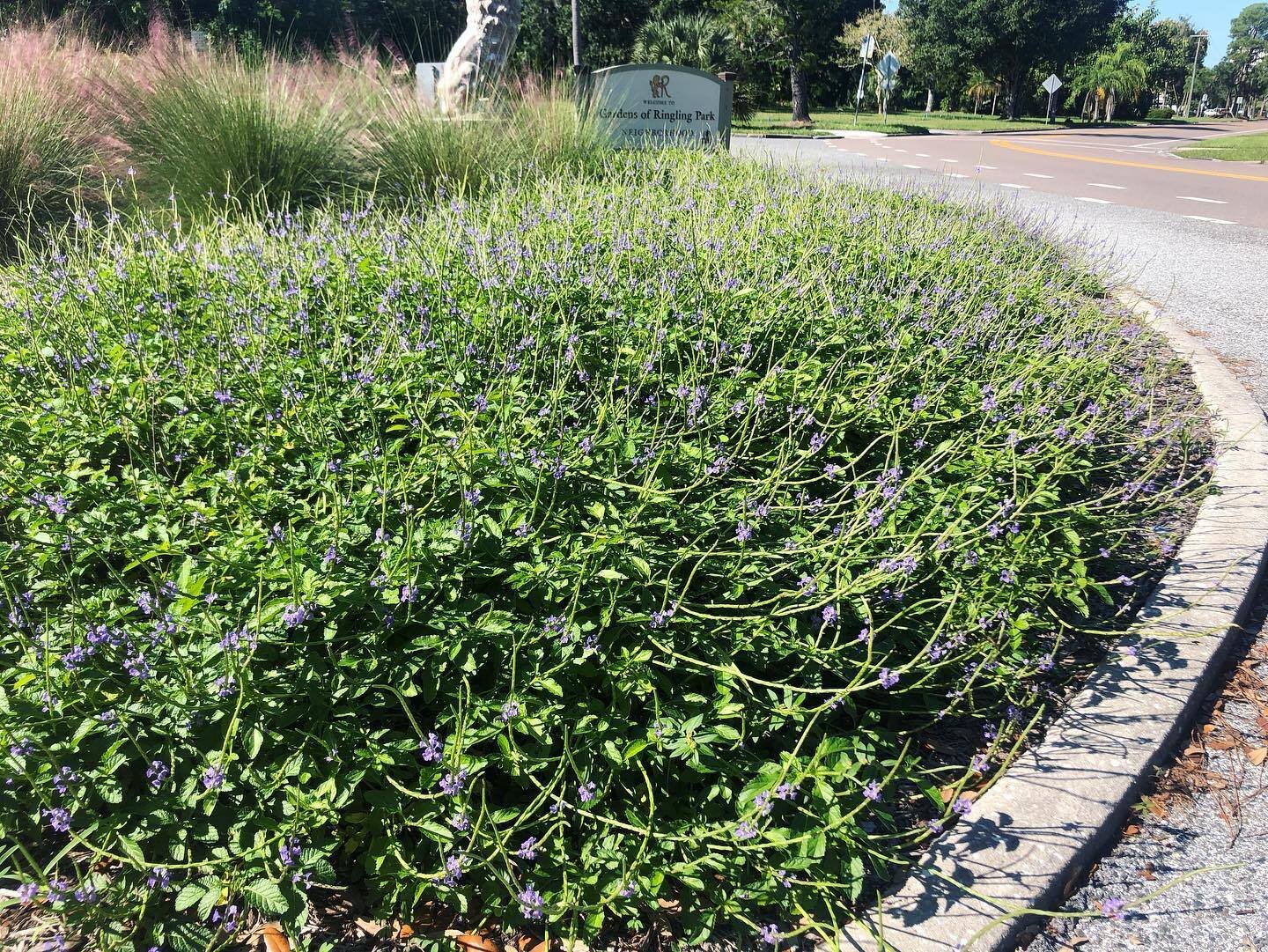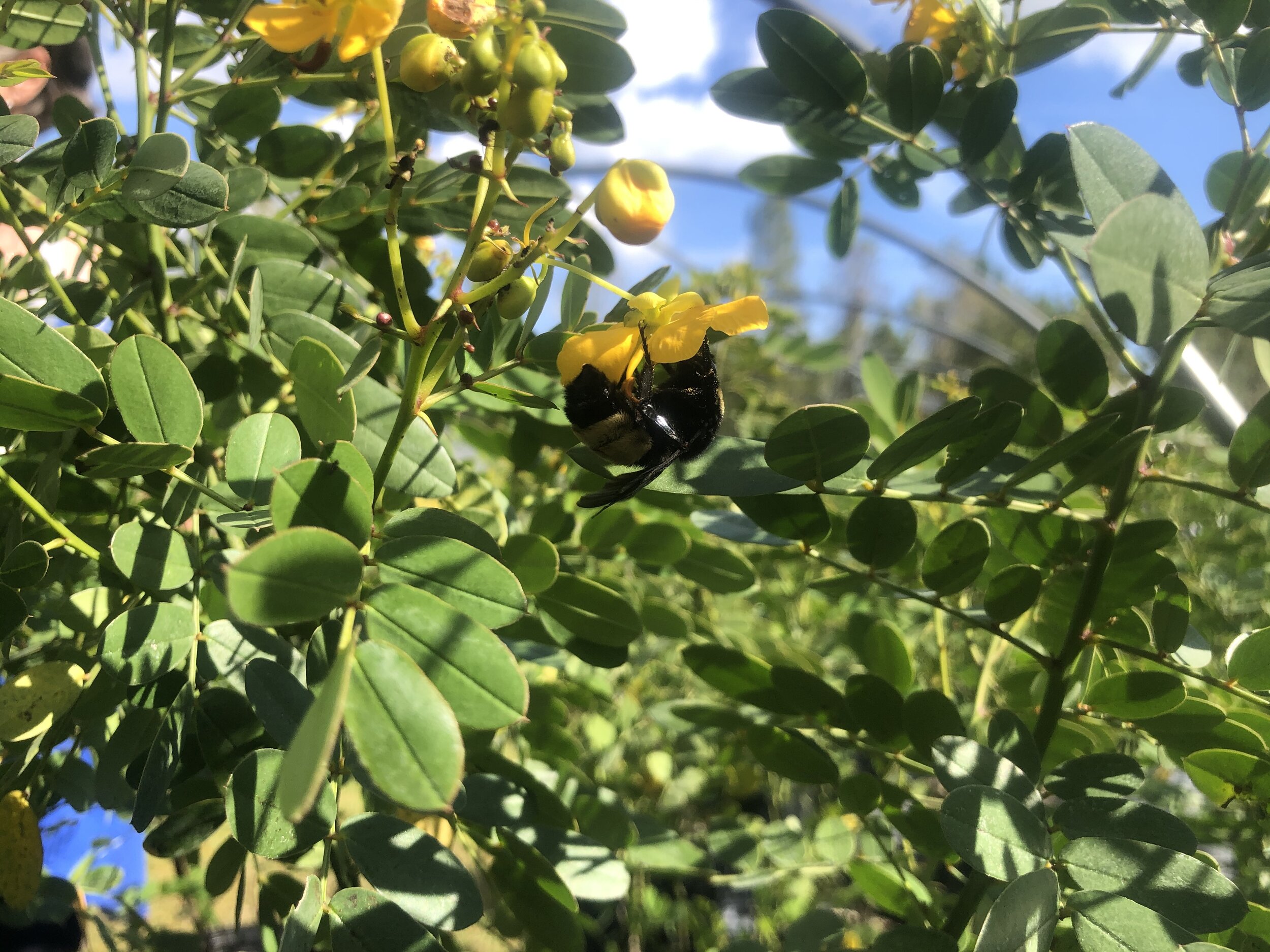Create a Florida-Friendly Yard or Community Space
Written by Laurel Schiller for Florida Native Plants Nursery
Photos and Format by Annie Schiller
Here’s our “take” on the University of Florida’s nine Florida-Friendly Landscaping principles, which emphasize sustainable landscaping choices for Florida.
Some terms to know before you read this:
Florida Native Plant A “Florida Native Plant” refers to a species occurring within the state boundaries prior to European contact. Florida native plants include those species understood as indigenous, occurring in natural associations in habitats that existed prior to significant human impacts and alterations of the landscape. (Florida Native Plant Society https://www.fnps.org/natives/definition)
Florida-friendly Plant Plants from anywhere in the world, including Florida native plants, that require little irrigation or fertilizer, are low maintenance and attract wildlife. (University of Florida, Florida-friendly Yards program https://ffl.ifas.ufl.edu/)
Invasive Plant A plant that grows so profusely that it takes over. Usually not native, though there are some natives (for example, cattails) which can take over in areas that have been altered (for cattail, areas with stabilized water levels and excess nutrients). Being non-native does not mean that a plant is invasive. Of the more than 20,000 plants that have been introduced to Florida, fewer than 300 are generally considered to be invasive (Florida Native Plant Society https://www.fnps.org/natives/definition)
University of Florida Principle #1.
Right Plant, Right Place. “Select plants suited for a specific location. Plants in the right place will thrive on minimal amounts of water, fertilizer and pesticides.”
Florida Native Plants Nursery:
Plants native to Florida have adapted to our climate, which combines cool dry winters, hot dry springs and hot humid summers. They thrive in nutrient-poor sandy soils that are either excessively drained or waterlogged after heavy rains. Coastal native plants are able to tolerate salt-laden winds and soils. Native trees have evolved to withstand tropical storm-force winds and some can even endure hurricane-force winds. Florida native plants, once established in the right place, do not need irrigation, fertilizer and pesticides.
Too often, plants from elsewhere in the world, labeled as Florida-friendly, are not. They require fertilizer, pesticides, irrigation and ongoing maintenance to remain healthy over time. Too often, Florida-friendly plants become “too friendly” and are removed from approved lists because they become invasive.
A residential road front entrance on Manasota Key that features thriving native plants like coontie, sabal palm and blue saw palmetto.
UF Principle #2.
Water Efficiently. “Irrigate only when your lawn and landscape show wilt signs. Water during cooler times of the day and check your irrigation system regularly for leaks and clogs.”
Florida Native Plants Nursery:
Florida native plants in the right place do not need irrigation. Florida is now the second most populous state in the nation. A thousand individuals are moving here a day. Our population is expected to double by 2070 (1000 Friends of Florida). Our aquifers are stressed. Over fifty percent of our potable water usage goes toward irrigation of lawns and landscape beds. Turf grass does not do well in Florida without irrigation, fertilizer and pesticides. These chemicals get into the groundwater, which pollutes our waterways. Mowing turf during the hot months is an expense to both energy and the pocketbook. Figure out how little lawn you can live with; surround it with other plantings that will absorb the chemical runoff and work toward eliminating it altogether.
Landscape plants can be watered by hand with a hose for the establishment period. A temporary, above ground irrigation system on timers can be installed if time or travel is a factor. Once the right native plants are established in the right places, they do not need irrigation even in the hottest months of the year.
A front yard in Brandon, Florida that has no lawn and instead, utilizes hardy native clump grasses, low shrubs, small trees and groundcovers along with 250 sand and crushed shell on pathways and against the house foundation.
UF Principle #3.
Fertilize Appropriately. “Apply fertilizers according to UF/IFAS recommendations and only when turf grass is actively growing. Never fertilize before a heavy rain.
Florida Native Plants Nursery:
Florida native plants in the right places do not require inorganic fertilizers. They’ve been growing unassisted for thousands of years. Let natural leaf litter accumulate beneath native plants. It will decompose over time and release readily available nutrients. Planting natives will help protect Florida’s water resources from contamination.
Native prostrate porterweed and muhly grass planted in full sun and harsh conditions in a roadside circular median in a residential area of Sarasota, Florida. These plants attract and feed numerous pollinators (are host plants as well) and require no fertilizers or irrigation once established.
UF Principle #4.
Mulch. “Maintain a 2-3 layer of mulch on landscape beds to retain soil moisture, prevent erosion, and suppress weed germination.”
Florida Native Plants Nursery:
Mulching protects the soil from drying out or heating up, so plants require less water. Mulch suppresses weeds. Leaves, pine needles, or wood chips from tree trimming are more sustainable than purchasing packaged mulch. (Source: Sustainable Gardening for Florida by Ginny Stibolt.) Make sure your commercial mulch choices are sustainably produced.
Example of a front yard in Sarasota, Florida with no lawn that utilizes pine straw mulch in the garden beds (existing pine trees on the property) and melaleuca mulch in the pathways. Eventually the plants will fill in and mulching will happen naturally from the plants leaf litter, but for the first few years, regular weeding and mulching helps with native plant establishment.
UF Principle #5.
Attract Wildlife. “Choose plants with fruits or berries to attract birds and other pollinators. Leave snags and increase vertical layering to provide wildlife habitat.”
Florida Native Plants Nursery:
Native plants bring life to your landscape. They are the natural food, shelter and nesting plants of our birds, butterflies, bees, other pollinators and wildlife. Native plants and wildlife have evolved together in an intricate food web. Native plants not only support diverse populations of resident wildlife but also migratory species that pass through Florida on their way to southern winter and northern summer ranges.
A native bee collecting on a flower from a native yellow necklacepod.
UF Principle #6.
Manage Yard Pests Responsibly. Practice Integrated Pest Management (IPM) for a healthy, sustainable approach to keeping your landscape safe from pest insects.”
Florida Native Plants Nursery:
There’s no need to use pesticides in native plant landscapes. Pesticides are widely used in homes and communities often without knowledge about the harm that they cause to children, pets and the environment. There are alternatives to pesticides for effective management of insects, rodents and weeds without exposing your family and neighbors to harmful toxic chemicals. (For more information see Beyond Pesticides.org)
Keep your foundations dry and inhospitable to pest insects by removing all plant material within six feet of foundation walls. Sweep away leaf litter from foundation walls and do not irrigate under eaves. Remove vegetation growing or leaning on walls as well as tree branches scraping walls and roof areas. These practices will eliminate habitat for pests and minimize algae and mold growth on walls.
Plant a diverse community of native plants to attract and provide habitat for beneficial insects and other wildlife that will feed on unwanted pest species.
Adding a sign to your yard can help inform those maintaining your property not to spray pesticides, herbicides or fungicides near or in your garden.
Example of 250 sand pathways around the house and appropriate spacing away from the house for native plants in a tight space in urban Sarasota, Florida.
UF Principle #7.
Recycle. “Return valuable nutrients to the soil and reduce waste disposal by composting turf grass clippings, raked leaves and pruned tree and plant parts.”
Florida Native Plants Nursery:
Turf grass and non-native plants are routinely fertilized and treated with toxic chemicals so grass clippings and plant parts from these sources should not be composted. Natural compost, from native and edible plants that have not been artificially fertilized, are full of microbes and humus providing an environment for the microbial activity needed to cycle or decay natural materials into nutrients. Compost also balances acidity and holds moisture and air in the soil. Creating compost recycles organic materials that might have added to the volume of landfills. Mix compost with surrounding soil when planting to help plants adapt sooner with less additional water. (Source: Sustainable Gardening for Florida by Ginny Stibolt)
UF Principle #8.
Reduce Stormwater Runoff. “Use features like earth shaping and rain gardens to keep rainwater on your landscape, rather than letting it run off into storm drains, carrying fertilizers, pesticides, soil and other debris.”
Florida Native Plants Nursery:
Water is a precious commodity. Direct roof runoff away from the foundation and towards plant beds. Plant and mulch beds along property lines to absorb moisture flowing toward storm drains. Plant low areas with native wetland plants that are adapted to periods of wet and dry conditions.
Native plants help absorb rain and storm water run off (also nutrients and pollution) before they leave your property and ultimately flow into the the Gulf of Mexico.
UF Principle #9.
Protect the Waterfront. “Protect the water body you live on from chemicals and debris. Designate a 10 foot maintenance – free zone between the shoreline and your landscape and do not fertilize, mow or apply pesticides in that area.
Florida Native Plants Nursery:
We recommend a 30 ft native plant buffer of trees, shrubs, native grasses and herbs between the shoreline and your landscape. This buffer will absorb runoff before it flows into waterways and provide wildlife habitat and wildlife corridors that will allow species to move from area to area in search of food and mates.
Example of a native plant buffer of layered shrubs and trees between two properties in Sarasota, Florida.












